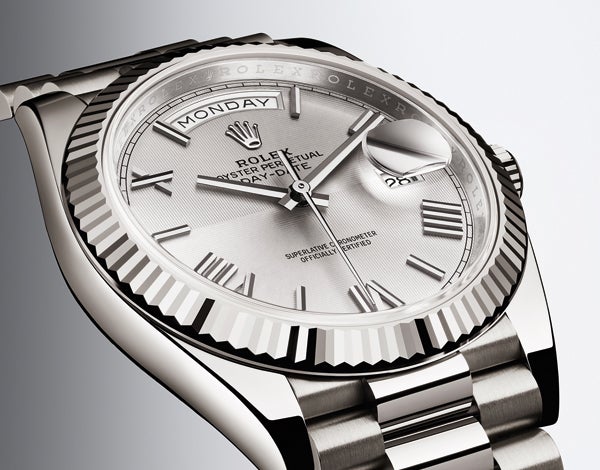

Watch auctions tend to reflect the prevailing mood, adjusting sentiment for or against this Patek or that Panerai, just as happens to the reputations of artists and makers in other spheres of interest. Occasionally, new themes and priorities emerge, more or less spontaneously, as with a recent flurry of interest for postwar Longines, or in response to external events such as the revival of Panerai in the late Nineties.
The auction houses can make markets themselves, through championing certain models and marques, but only occasionally can they shift the centre of gravity enough to feed back into the wider watch world. Take Antiquorum’s 1989 ‘Art of Patek Philippe’ sale, which played a major part in propelling the Geneva watch brand from top of the league to a league of its own by establishing the idea that Patek watches retained or grew value in a way that other marques could not.
Similar single-brand, thematic auctions helped secure collector sentiment for Breguet, Omega and Vacheron Constantin in later years, though without quite having the impact of the Patek sale. In each case, the contemporary output of the brands concerned benefited from the reflected glow.
Phillips’s glamorous Rolex Day-Date auction, held in Geneva back in May, won’t have quite the impact of those big thematic sales, but I think it will be influential, at least in part because it reflects a shift in taste that was already emerging. The sale concentrated on watches that Rolex made, mostly in the Seventies through to the Nineties, in response to particular, and sometimes rather peculiar, requests from its dealers.
In pure auction terms, it was no match for Christie’s Daytona Lesson One sale in November 2013, but these Rolexes seem to offer something more in terms of what they say about contemporary watchmaking taste and design. Prices weren’t insignificant: the average hammer price was just over CHF100,000 (£68,000) across 60 lots. The highest price was achieved by the ‘Big Kahuna’, one of only two known model 6612s made in platinum, which went for a record-breaking CHF473,000 (£322,000).
Good as the hammer prices were, the importance of the sale lay in what it revealed about why we like watches, the brand’s history, the art of collecting and how taste in watch design evolves. All these themes come together in the story of the Day-Date and in the watches from this sale. The watch that became known as the President (not least because Eisenhower, Kennedy, Ford and even Mao Zedong wore it) was launched in the Fifties as a technically advanced dress watch. Automatic from the start, water- and shock-resistant to levels more associated with sports watches and almost invariably made in precious metals, the Day-Date has a fairly simple design at heart which allows the details of numbers, hands and bezel to give it character. It’s been able to adapt to shifting tastes throughout half a century with ease.
The way Rolex has managed the model also reflects how the company has changed — it’s easy to forget that Rolex has not always been the behemoth it is today. It produced 25,000 chronometers a year when the Day-Date was launched, compared to the current estimate of a million-plus per year. Numbers aside, the way Rolex operated was completely different from the vertically integrated production the brand has in place today: it relied on external suppliers for everything from movements to cases and dials. It was only in the Nineties that Rolex started the process ofacquisition and centralisation that reduced a mixed portfolio of 25-plus manufacturing sites and suppliers down to the four sites that Rolex operates today.
But in that process something, as this sale shows, was lost. The pre-centralisation Rolex was a much more freewheeling and creative enterprise, seemingly happy to work with retailers and clients in a way that was lost as the brand grew (though that might be natural change). Almost all the auction’s watches were produced in response to feedback from retailers, and the results are spectacular. Take the hard-stone dials that the sale opened with — jasper, onyx and marble were used, as were tiger’s-eye and malachite, all materials that are hard to imagine in today’s Rolexes. Quality control would, you suspect, have a fit at the very idea of using a material so innately brittle.
But as these watches show, it’s not just mechanical risks that Rolex was prepared to take: the designs have a splendour and front that you would struggle to find outside Hublot today.
These are not the generally sober, if elegant, Day-Dates that populate the brochures and windows of the watch world’s most tightly controlled brand. The 60 lots in the auction show an almost shocking playfulness and lightness of touch — the ‘Stella’ lacquered dials in candy pink, turquoise, green and even a rich yellow were produced to the impeccable standards you’d expect of Rolex, but to an effect that you might not.
It’s these standards and the impeccable craftsmanship that has gone into the watches that stop these from becoming a mere sideshow, however.
The craft skill evident in the execution of the bark finish applied to the President bracelet is breathtaking, as is the freedom seen in the Gerald Genta-inspired ‘Emperor’, made, according to the catalogue, for the Shah of Iran. The latter has a burgundy ‘Stella’ dial to match the platinum case, a combination that amply justifies the title.
The sale shows that a confident company, working with retailers and clients that knew and trusted their taste, could create something special, and surely there’s a lesson here for contemporary brands. As the focus on mega-complications has largely retired to the background, luxury brands have been switching their attention to well-made, simpler watches that reflect their brand DNA. But brand DNA is not necessarily enough, particularly once it’s been purified and filtered through marketing departments and design bureaux. I think it’s time brands learned to trust the tastes of their partners, to free some of the constraints on their self-expression and take some risks. It didn’t seem to do Rolex any harm.
Intriguingly, there’s a sense that Rolex is going through a subtle shift in emphasis, as the new Day-Date 40 reveals. Of course there are the technical refinements that are the brand’s hallmark — the watch has both minor enhancements such as ceramic tubes for the bracelet roll-pins and a new movement that is a game-changer in reliability terms. Alongside these most Rolex-ish of developments, there was something else: a much sharper, bolder design, a stronger flavour achieved through a better case shape, laser-etched dials and reworked fluting on the bezel. This isn’t quite the Rolex of more freewheeling years, but the direction of travel looks great.






